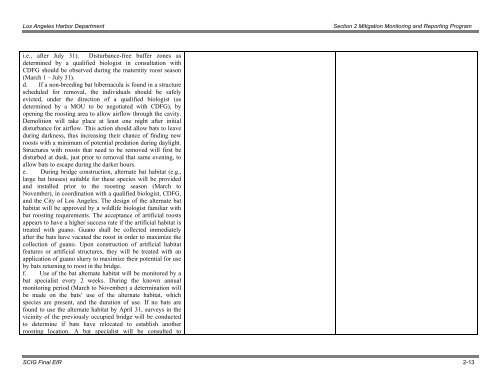Final Mitigation Monitoring and Reporting Program (MMRP)
Final Mitigation Monitoring and Reporting Program (MMRP)
Final Mitigation Monitoring and Reporting Program (MMRP)
You also want an ePaper? Increase the reach of your titles
YUMPU automatically turns print PDFs into web optimized ePapers that Google loves.
Los Angeles Harbor Department Section 2 <strong>Mitigation</strong> <strong>Monitoring</strong> <strong>and</strong> <strong>Reporting</strong> <strong>Program</strong><br />
i.e., after July 31). Disturbance-free buffer zones as<br />
determined by a qualified biologist in consultation with<br />
CDFG should be observed during the maternity roost season<br />
(March 1 – July 31).<br />
d. If a non-breeding bat hibernacula is found in a structure<br />
scheduled for removal, the individuals should be safely<br />
evicted, under the direction of a qualified biologist (as<br />
determined by a MOU to be negotiated with CDFG), by<br />
opening the roosting area to allow airflow through the cavity.<br />
Demolition will take place at least one night after initial<br />
disturbance for airflow. This action should allow bats to leave<br />
during darkness, thus increasing their chance of finding new<br />
roosts with a minimum of potential predation during daylight.<br />
Structures with roosts that need to be removed will first be<br />
disturbed at dusk, just prior to removal that same evening, to<br />
allow bats to escape during the darker hours.<br />
e. During bridge construction, alternate bat habitat (e.g.,<br />
large bat houses) suitable for these species will be provided<br />
<strong>and</strong> installed prior to the roosting season (March to<br />
November), in coordination with a qualified biologist, CDFG,<br />
<strong>and</strong> the City of Los Angeles. The design of the alternate bat<br />
habitat will be approved by a wildlife biologist familiar with<br />
bat roosting requirements. The acceptance of artificial roosts<br />
appears to have a higher success rate if the artificial habitat is<br />
treated with guano. Guano shall be collected immediately<br />
after the bats have vacated the roost in order to maximize the<br />
collection of guano. Upon construction of artificial habitat<br />
features or artificial structures, they will be treated with an<br />
application of guano slurry to maximize their potential for use<br />
by bats returning to roost in the bridge.<br />
f. Use of the bat alternate habitat will be monitored by a<br />
bat specialist every 2 weeks. During the known annual<br />
monitoring period (March to November) a determination will<br />
be made on the bats’ use of the alternate habitat, which<br />
species are present, <strong>and</strong> the duration of use. If no bats are<br />
found to use the alternate habitat by April 31, surveys in the<br />
vicinity of the previously occupied bridge will be conducted<br />
to determine if bats have relocated to establish another<br />
roosting location. A bat specialist will be consulted to<br />
SCIG <strong>Final</strong> EIR 2-13
















